The advantages and disadvantages of stretch ceilings are one of the most popular and hotly discussed topics on all sorts of network forums dedicated to construction and repair. By the user who wants to familiarize himself with this issue and to reflect the feasibility of installing such a design, the whole flow of information is increasing, often contradictory and controversial. In such an abundance of opinions and arguments, it is not easy to figure out and get an objective idea of the attractive sides of stretch ceilings and their minuses.
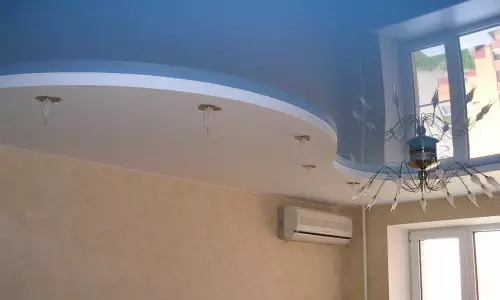
The variety of types of stretch ceilings allows you to make repairs in the room in any style.
Types of stretch ceilings
To reasonably judge the qualities of the stretch ceiling, you should first look at it more closely. The idea of facing the ceiling stretched canvas appeared in France, so the stretch ceiling is often called French. Currently, 2 types of such structures are used:
- with cloth from fabric;
- With polyvinyl chloride (PVC) film.
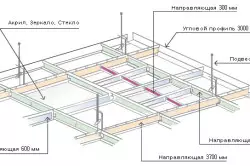
Installation of stretch ceiling by a wedge method.
The most affordable from the point of view of the cost is a stretch ceiling from the vinyl film, but it is possible to call it cheap only in comparison with the tissue stretch ceiling. In relation to other types of finishes (suspended structures, plaster), even PVC ceiling is more expensive, the difference in price will be quite tangible.
The fabric ceiling has another name - seamless. Indeed, on such a ceiling never happens and cannot be seams, because it is mounted only in solid form. The maximum size of the room in which the stretch ceiling of this type can be washed, the width of the standard roll is limited and is 5 m. The limit width of the PVC film today is only 3.5 m, and such a canvase appeared quite recently. Therefore, in most cases, vinyl stretch ceilings have welded seams. It should not be worried about the strength of this seam: it is performed using high-frequency electrical welding and, as the test shows, is more durable than the PVC film itself is in its pure form. However, on some types of film (depends on the invoice) it becomes noticeable.
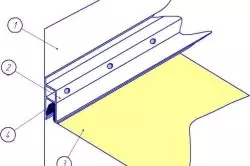
Installation of the stretch ceiling with harpoon: 1 - wall, 2 - fastening baguette, 3 - web tension ceiling, 4 - harpoon.
It is very common is the opinion according to which the tissue stretch ceilings are made only from natural materials. This is not true. To produce such a tissue, a polyester thread is used, in addition, the finished canvas is impregnated with polyurethane.
Article on the topic: Decorative concrete: Printed and stamped with his own hands, Decor and technology of formulations, video and press
Stretch ceilings such as fabric and vinyl, fixed on a frame of aluminum or plastic planks, which are called baguettes. Baguettes are attached to the walls under the capital ceiling throughout the perimeter of the room. When using standard size planks, the height of the room will decrease by 30-40 mm. But there are special varieties - the so-called mini-baguettes. Thanks to the compact dimensions, they allow you to reduce the gap between the main ceiling and tensioning up to 15 mm.
Installation of the fabric ceiling is quite simple and does not require the use of special technical devices. The vinyl ceiling after fastening on the frame, it is necessary to heat the heat flush to the temperature of 80 °. After cooling, the film will stretch, forming a smooth and flawlessly smooth surface. Many mistakenly believe that the process of heating the vinyl film for a while turns the room into the sauna and leads to disastrous consequences for wooden furniture, windows and doors. Do not fear such effects. Only the ceiling can be heated, and since the finest vinyl film (0.15-0.25 mm) does not give noticeable infrared radiation, temperature changes can only be felt at a distance of several centimeters from it. True, the use of a heat gun can lead to undesirable effects regarding home plants, so at the time of installation it is better to take them out of the room.
Consider the advantages and disadvantages of this type of ceilings.
The advantages of stretch ceilings
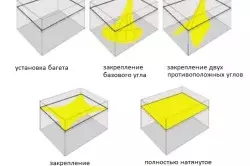
Stages of mounting stretch ceiling.
The main advantage of stretch ceilings regardless of the type of web is their leveling effect. They form an ideal flat plane, and this result is achieved by much less effort than with plastering or mounting suspended structures.
In addition, the test ceilings are inherent in the following positive qualities:
- Aesthetic advantages. Stretch ceilings - a very attractive solution from the point of view of design, but only if we are talking about the PVC film. This material provides a designer to a truly unlimited set of features. Vinyl film can be glossy, matte or translucent, its various types are mimicing marble, leather, wood. PVC ceilings with a pearl sampling are quite popular, with the texture for metal, suede or with imitation of the lacquered surface. Each of the textures is available in a wide range of colors - about 200 different shades. The aesthetic qualities of fabric ceilings can be attributed more to disadvantages than advantages. All ceilings of this type have a monotonous rough texture, reminiscent of the plastered ceiling, no less scarce is also a color gamut - only 10 inexpressive shades of a soft pastel nature.
- Installation speed. The installation of the stretch ceiling can be performed in 3-4 hours regardless of the area of the room.
- Durability. Various manufacturers of stretch designs provide their products from 10 to 12 years old, but the actual service life of this type of ceilings significantly exceeds this period and is about 50 years. During all this time, the stretch ceiling will not require repair or even care.
- Waterproof. The owner of the stretch ceiling may not be afraid of the flood in his home, even if the neighbors turn their apartment into the pool on top. The canvas of stretch ceilings of all types are waterproof, seeping through the interoaded overlap of water is simply going to them, not falling into the room. At the same time, the ceiling is able to delay the quite solid volume of water: as shown tests, 1 sq. M of the canvas withstands the load from 100 liters of water. In this regard, the vinyl film is a more profitable option than the ceiling of the fabric. First, it is stretched, and therefore it can accommodate a larger amount of water. Secondly, after drying, the PVC ceiling will be fully restored, while the tissue will only be thrown away.
Article on the topic: How to make the design of the living room in a classic style
Other advantages
The stretch ceiling allows you to make an invisible gasket of pipes, wiring or ventilation boxes in the gap between it and the main ceiling.
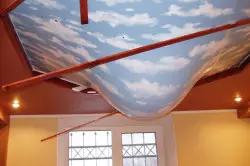
When flooding the room from above, the stretch ceiling is withstanding up to 100 liters of water.
Installation of built-in point lamps is possible. A very spectacular solution is a translucent canvas in combination with lamps installed above it. Lighting is soft and like smoking from nowhere.
Such properties include such properties:
- Heat and sound insulation qualities: This advantage is due to the presence of an air layer between the stretch ceiling and the basic. For improving sound insulation properties, blades with perforation.
- Lack of condensate: In rooms with high humidity (kitchen, bathroom, room with a swimming pool or large aquarium) due to the temperature difference on the ceiling can be formed condensate. It is unavailable to stretch ceilings, because due to the low thickness of the canvas, they always have a temperature corresponding to the room temperature.
Disadvantages of stretch ceilings
Despite such a large number of positive qualities, the tensioning ceilings are inherent in the disadvantages.
First, the cost. The installation of the stretch ceiling costs about $ 30 per 1 sq. M, thus, in value, this type of finish is significantly ahead of other options. Independent installation without loss of quality is impossible, so it will not be possible to save.
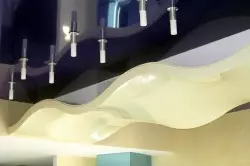
Materials used in the manufacture of multi-level ceiling correspond to fire safety standards.
Secondly, sensitivity to temperature. A close neighborhood with lamps can end for the stretch ceiling very poorly. In this connection, their power should not exceed 60 W for incandescent lamps and 35 W for halogen, provided that the thermally insulating ring is used.
The lamps with greater power must be located at a distance of 150 mm from the canvas. To the cold, stretch ceilings are also not adapted. They are afraid not only negative temperatures, but also a sudden cooling in the range of 5 °.
Article on the topic: How to drive out air from the heating system
Such a situation is possible if, for example, air conditioning instead of the mode of heating installed by error cooling or the room it was necessary to urgently venture in the cold period of the year.
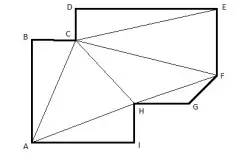
For deletion.
The ceiling canvas is cracking, its recovery is already impossible in this case. An increase in temperature is also undesirable because it can provoke a tension ceiling. The probability of such a phenomenon is higher than the larger the area of the canvas, therefore, the installation of the structures of this type in the rooms with an area of more than 20 square meters is not recommended.
Third, sensitivity to pressure drops. The pressure difference between the main premises and space over the stretch ceiling can lead to its collapse. Especially often such a phenomenon is observed when opening doors or windows.
Fourth, the canvas is afraid of sharp items. The strength of the suspended ceiling cannon does not cause doubt, when testing it easily withstands the weight of an adult, who can also jump on it. But even easy contact with a sharp object ends with a rupture of the material, after which it will only be left to throw it away.
Fifth, the complexity of cleaning. Stretch ceilings do not require any care, but if the mud is somehow on the canvas, it is not easy to remove it. For this you have to use only soft rags or sponges that cannot be strongly pressing to the ceiling due to the specifics of its device.
